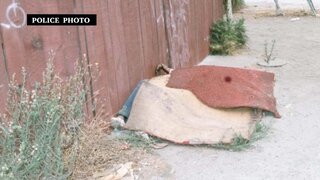Create a free profile to get unlimited access to exclusive videos, breaking news, sweepstakes, and more!
The ‘Grim Sleeper’ Serial Killer Left A Trail Of Bodies In Los Angeles For 2 Decades
Familial DNA and pizza helped the LAPD finally catch the "Grim Sleeper" serial killer.
In 1980s Los Angeles, as the city reeled amid the crack cocaine epidemic and gang warfare, the bodies of Black women were repeatedly found stashed in alleyways.
Debra Jackson, a single mother of three, was one of them. She was shot three times with a .25-caliber gun, an autopsy revealed.
She was “discarded like a piece of garbage,” an investigator told Mark of a Serial Killer. Jackson’s case eventually went cold.
In August 1986, the body of another woman who’d been shot by a .25-caliber handgun was dumped in an alley. The pattern of the bullet wounds suggested the victim, identified through fingerprints as 24-year-old single mom Henrietta Wright, was in a car when the killer fired.
Investigators didn’t immediately link the two cases, but analysis of the bullets showed that the same gun was used to kill both women. Detectives worked various leads, focusing on the murder weapon. But progress stalled.
In January 1987, an anonymous 911 tipster reported witnessing a woman’s body being tossed into an alley. He shared the license plate of the van the perpetrator was in. At the scene, investigators discovered a woman later identified as 23-year-old Barbara Ware. She was fatally shot in the chest with a .25-caliber gun.
Detectives traced the license plate of the van to a church, where keys to the vehicle were easily accessible to almost anyone. As detectives reckoned with their lead being a dead end, they questioned who reported seeing the crime.
In a dark alley, how would the caller know the victim was a woman or see the license plate? Was the killer the 911 caller?
The gun used to kill the third victim was found to match the one in the Jackson and Wright homicides. In addition, saliva and semen was collected from the latest victim.
In the late 1980s, however, there was no national DNA database to point investigators to a suspect. A search of the van yielded no useful evidence.
The bodies of four more women — Bernita Sparks, Mary Lowe, Lachrica Jefferson, and Monique Alexander — who’d been shot with the same .25-caliber gun and dumped, were found by January 1988.
In the spring of 1988, the case took a dramatic turn. Then-30-year-old Enietria Margette was walking to a friend’s house and accepted a ride from a man. En route he shot her in the chest, raped her, took a Polaroid picture, and pushed her out of the car, she told authorities. She miraculously survived.
RELATED: L.A. Serial Killer Louis Craine Strangled 4 Women in Cold Blood: "He Gets Very Angry"
Washington gave authorities a description of the shooter and his orange Pinto. But still, the case went cold for 20 years. During those two decades, advances were made in the use of DNA evidence.
Then, on New Year’s Day, 2007, the body of a woman, identified by fingerprints as Janecia Peters, was found in a dumpster in an alley. She was killed by a .25-caliber gun.
Genetic material recovered from Peters’ body matched DNA on a 2003 murder victim, Valerie McCorvey, and 2002 victim Princess Berthomieux. All three women had been shot.
Investigators connected the dots between the recent homicides and murders from the 1980s. When they submitted the DNA from the earlier cases for comparison with the new cases, they matched. But the DNA profile didn't offer up a name.
Familial DNA tracing, a new innovation, failed to generate a lead.
The LAPD put the word out to the public, hoping to generate more leads. LA Weekly journalists referred to the murderer as the Grim Sleeper, referring to his absent period. Investigators, however, believed that he wasn’t inactive during that time.
“We know he wasn’t sleeping,” LA Homicide Det. Dennis Kilcoyne, who worked the case, told The Daily Beast in 2016.
The case stalled until July 2010. Christopher Franklin was arrested then on a firearms charge and had to submit DNA. His genetic material was a familial match to the DNA found at the women’s murders.
Although he was too young to be a suspect, his father, Lonnie David Franklin Jr. was the right age. Born and raised in California, he was married for 30 years and had two kids. In the ’80s, he worked for the L.A. Sanitation Department. He seemed like a regular guy, the Los Angeles Times reported.
Investigators surveilled Lonnie Franklin around the clock. They caught a break when he went to a pizza parlor, where a detective was able to pose as a busboy and collected food, utensils, and napkins Franklin used to covertly get a DNA sample.
On July 7, 2010 the LAPD Crime Lab compared the suspect’s DNA to evidence found from several Grim Sleeper murder victim scenes. There was a match. Detectives rounded up and charged Lonnie Franklin, who denied guilt.
When police searched Franklin’s home they found three .25-caliber handguns, including one that matched the murder weapon. They also found hundreds of photos of women.
Authorities dug into his past and found that he was convicted in a gang rape of an 18-year-old woman while in the Army. During the attack, the soldiers snapped pictures of the assault, a depraved way to preserve the violence that Franklin never gave up. He was sentenced to three years.
“But somehow Lonnie was able to get out of prison and he got a general discharge,” Kilcoyne told “Mark of a Serial Killer.”
After a number of delays, Lonnie Franklin’s trial began in February 2016. Three months later he was convicted of 10 murders and one attempted murder. On August 10, 2016, he was sentenced to death.
On March 28, 2020, Lonnie Franklin, 67, died of natural causes in his prison cell at San Quentin State Prison.
Investigators believe that he may be responsible for the murders of at least two dozen more women.
To learn more about the case watch Mark of a Serial Killer or the Oxygen special Serial Killer Capital: Los Angeles.



































